I've tested controlling single 24VDC relay with Arduino by using external power source to power the relay. Now I've set up a board to control several of these relays, but noticed that the Arduino output does not trigger the relay it did before. I've looked but haven't found any threads about multiple relays and board configuration.
I noticed that when I removed all output pins from Arduino (only inputs from buttons connected), the Arduino worked flawlessly (led indication). Something seems to be affecting Arduino or the output pin section of the board or causing the relay not to function properly.
The problem is that Arduino does not seem to register the signal from the input when output pins are connected. Only after several pushes or long delay, the relay is triggered again.
Is there something that I could fix or add to the board to make it more reliable?
Could common 24 VDC rail be causing problems when there are several relays on the same board (is the position of the diode right when there are multiple relays)?

Relay specs: FINDER - 46 Series; Coil voltage and current: 24 VDC and 20 mA; Coil resistance: 1.2kohm. More details of the relay can be found from here: http://uk.farnell.com/finder/46-61-9-024-0074/relay-spco-16a-24vdc/dp/1329676